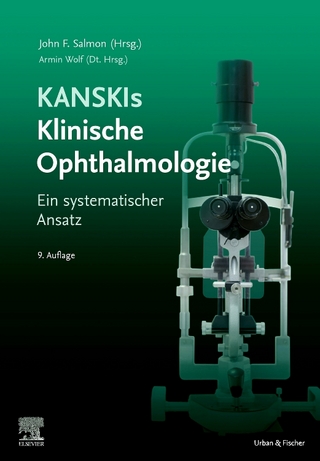
2022-2023 Basic and Clinical Science Course™, Section 08: External Disease and Cornea
Seiten
2022
American Academy of Ophthalmology (Verlag)
978-1-68104-548-1 (ISBN)
American Academy of Ophthalmology (Verlag)
978-1-68104-548-1 (ISBN)
Discusses the structure and function of the cornea and external eye and reviews relevant examination techniques. This section also includes statistics on indications for corneal transplants, and discusses infectious and ocular surface diseases; disorders and surgery of the ocular surface; and congenital anomalies and degenerations.
The Academy's Basic and Clinical Science Course™ is ophthalmology’s definitive source of clinical information. Practicing ophthalmologists and residents worldwide use the BCSC® to ensure the highest-quality patient care. Each of the 13 volumes includes up-to-date clinical knowledge, concise information, tables, self-assessment questions with answers, photos and illustrations and opportunities for earning AMA PRA Category 1 Credit™.
Beginning with the 2013–2014 edition, the Academy and the European Board of Ophthalmology (EBO) have partnered to make the BCSC® the standard text for all European ophthalmology training programs. The EBO now recommends the BCSC® as the primary educational resource for European trainees and ophthalmologists studying for the annual EBO Diploma Exam.
Section 8 discusses the structure and function of the cornea and external eye and reviews relevant examination techniques.
It covers the latest statistics on indications for corneal transplants from the eye bank Association of America. Plus, discusses infectious and ocular surface diseases; disorders and surgery of the ocular surface; immune-mediated and neoplastic disorders; and congenital anomalies and degenerations. A chapter on the diagnosis and management of corneal dystrophies reflects the IC3D classification of the dystrophies according to a template consisting of clinical, pathologic, and genetic information. Toxic and traumatic injuries and corneal transplantation are also reviewed.
Interactive elements throughout the text help to build your knowledge and include an activity on corneal layers and corresponding confocal images; an animation demonstrating the development of the cornea; and a corneal ectasia case study. Eleven original narrated technical videos demonstrating select surgical techniques, including animations will also aid your understanding.
This section also covers diagnostic imaging technologies, endothelial replacement surgery updates and best practices for sebaceous cell carcinoma early recognition and treatment.
Upon completion of Section 8, readers should be able to:
Explain the overall strategy, examination, and technology used for systematic evaluation of the cornea and the external eye.
Describe the basic principles and the clinical approach to the diagnosis and treatment of viral, bacterial, fungal, and parasitic keratitis.
List the risk factors, clinical signs, and breadth of management options of corneal ectasia.
List the risk factors, diagnosis, and treatment of neoplastic disease of the cornea and the external eye.
Identify unique clinical features that help differentiate the more common corneal dystrophies and describe an appropriate management strategy for each.
Identify the common corneal manifestations of systemic disease and describe their treatments.
Last Major Revision: 2021-2022
The Academy's Basic and Clinical Science Course™ is ophthalmology’s definitive source of clinical information. Practicing ophthalmologists and residents worldwide use the BCSC® to ensure the highest-quality patient care. Each of the 13 volumes includes up-to-date clinical knowledge, concise information, tables, self-assessment questions with answers, photos and illustrations and opportunities for earning AMA PRA Category 1 Credit™.
Beginning with the 2013–2014 edition, the Academy and the European Board of Ophthalmology (EBO) have partnered to make the BCSC® the standard text for all European ophthalmology training programs. The EBO now recommends the BCSC® as the primary educational resource for European trainees and ophthalmologists studying for the annual EBO Diploma Exam.
Section 8 discusses the structure and function of the cornea and external eye and reviews relevant examination techniques.
It covers the latest statistics on indications for corneal transplants from the eye bank Association of America. Plus, discusses infectious and ocular surface diseases; disorders and surgery of the ocular surface; immune-mediated and neoplastic disorders; and congenital anomalies and degenerations. A chapter on the diagnosis and management of corneal dystrophies reflects the IC3D classification of the dystrophies according to a template consisting of clinical, pathologic, and genetic information. Toxic and traumatic injuries and corneal transplantation are also reviewed.
Interactive elements throughout the text help to build your knowledge and include an activity on corneal layers and corresponding confocal images; an animation demonstrating the development of the cornea; and a corneal ectasia case study. Eleven original narrated technical videos demonstrating select surgical techniques, including animations will also aid your understanding.
This section also covers diagnostic imaging technologies, endothelial replacement surgery updates and best practices for sebaceous cell carcinoma early recognition and treatment.
Upon completion of Section 8, readers should be able to:
Explain the overall strategy, examination, and technology used for systematic evaluation of the cornea and the external eye.
Describe the basic principles and the clinical approach to the diagnosis and treatment of viral, bacterial, fungal, and parasitic keratitis.
List the risk factors, clinical signs, and breadth of management options of corneal ectasia.
List the risk factors, diagnosis, and treatment of neoplastic disease of the cornea and the external eye.
Identify unique clinical features that help differentiate the more common corneal dystrophies and describe an appropriate management strategy for each.
Identify the common corneal manifestations of systemic disease and describe their treatments.
Last Major Revision: 2021-2022
| Erscheinungsdatum | 17.08.2022 |
|---|---|
| Verlagsort | San Francisco |
| Sprache | englisch |
| Gewicht | 1160 g |
| Themenwelt | Medizin / Pharmazie ► Medizinische Fachgebiete ► Augenheilkunde |
| ISBN-10 | 1-68104-548-6 / 1681045486 |
| ISBN-13 | 978-1-68104-548-1 / 9781681045481 |
| Zustand | Neuware |
| Haben Sie eine Frage zum Produkt? |
Mehr entdecken
aus dem Bereich
aus dem Bereich
Ein systematischer Ansatz
Buch | Hardcover (2022)
Urban & Fischer in Elsevier (Verlag)
265,00 €


